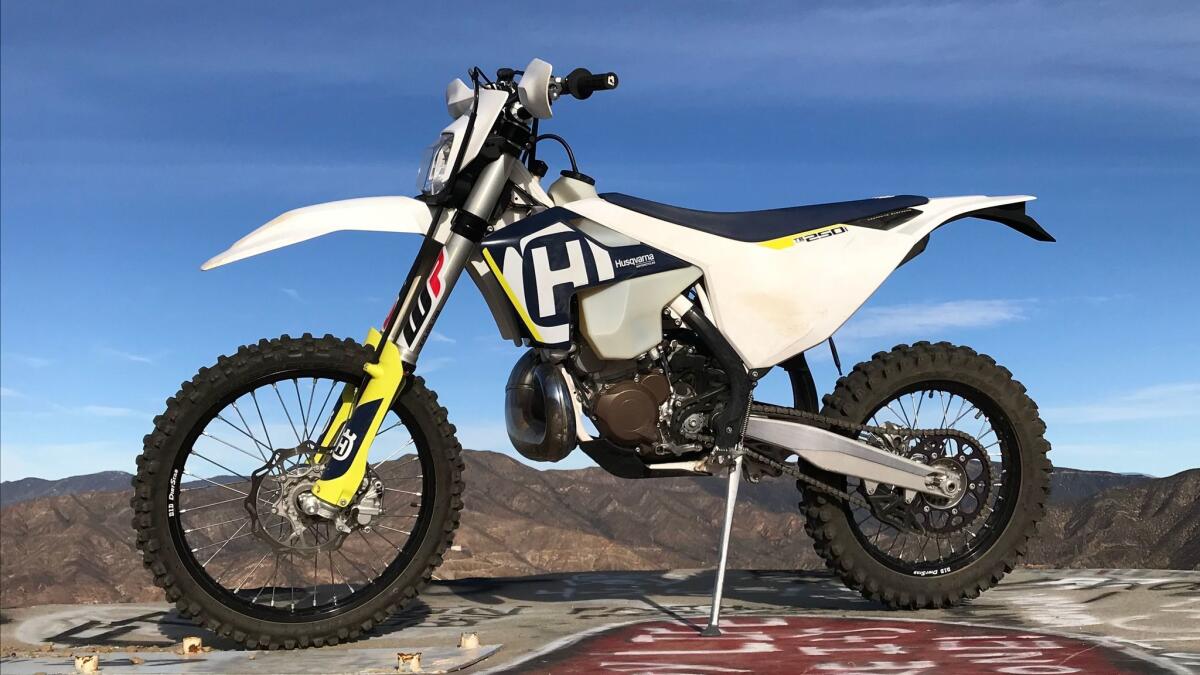Review: Is this the future of dirt bikes? Husqvarna’s fuel-injected 2-stroke

Husqvarna has beaten its sister company, KTM, to market with the long-awaited fuel-injected two-stroke TE250i dirt bike.
It’s a game changer. For the first time in modern history, there is a proper off-road motorcycle that has all the torque, power and mechanical simplicity of a two-stroke engine without requiring the operator to mix gas and oil for fuel and demanding jetting adjustments for changes in elevation.
With an electric starter.
This could spell big sales for the blue-and-yellow marque, which in its 1960s heyday reached the pinnacle of dirt bike dominance.
The motorcycle world has been waiting impatiently for off-road giant KTM to build and begin selling its version of the fuel-injected two-stroke, the 250 XC-W TPI. Reviewers who flew to Europe to participate in test rides came back with glowing reviews. Eager California dirt bikers started laying down deposits.
But owing to the crafty use of production schedules, Husqvarna, which has overlapping ownership with KTM and shares factory floor with the Austrian company, got there first.
I spent a half-day tooling around the Santa Clarita trails on a TE250i in early December, and I loved everything about it.
It’s a purpose-built enduro or trail bike, designed to go direct from the distributor to the dirt.
Weighing in at only 230 pounds dry, and beautifully sprung with WP Xplor 48 front forks and a WP rear shock, the new Husky felt as fresh and frisky as a mountain bike.
Skipping over rocks and ruts, tackling hill climbs and sliding fire roads, the bike felt intuitive and capable — remarkably so for an out-of-the-box motorcycle.
On one long sandy uphill, I was marveling at how light the front end felt. Then I realized the front end wasn’t actually touching the ground, as the little Husky held a low-elevation wheelie until I crested the top.
I liked it even better after tweaking the adjustable suspension, but that hardly mattered. I was at home on this bike five minutes after firing it up.
A soft-clutch handle eases gear changes in the six-speed transmission. First gear allowed for rock crawling and fifth gear was perfect for high-speed fire roading. I never made it to sixth.
Magura brakes provided the stopping power, though I found the rear braking not very effective — which might have had as much to do with the slippery, bone-dry dirt we were on as the brakes themselves.
Like all two-stroke dirt bikes, the 250i’s engine spins up fast from the confident low-end torque to the screaming high-end revs.
But unlike a lot of two-strokes, especially those made by KTM, the power band is smooth and linear, producing no sudden surprises.
More importantly, unlike many modern two-strokers, the 250i requires no fuel mixing. Oil stored near the gas tank mixes with gasoline automatically, as needed, and requires topping only once every five to seven tanks of gas, Husqvarna said.
That opens up a lot of territory, literally, for wannabe adventurers. Long-distance two-stroke riders used to have to carry oil canisters with them and then worry about mixing accurately at the pump. Now, they just pump. The 2.4-gallon gas tank and a reported 30% to 40% improvement in fuel economy over the previous version means this bike will go a while before running out of juice.
The stock mix felt a little rich to me, and the engine felt cleanest at high RPMs. (A more technically capable person might be able to mess with the engine mapping and change that.) But the tailpipe didn’t emit any smoke and showed no excess oil even after two hours of work.
Quibblers may carp about the 38-inch seat height, or at Husky’s continued use of its highly impractical side stand, or the suspension link that hangs down below the level of the engine, which could hang a rider up on a log or rock crossing.
There also may be those who think a 250cc engine is too small. For them, Husky is building a 300cc two-stroke.
But the veteran two-smoker who went riding with me, a man who has owned so many KTMs that he bleeds orange, rode the TE250i for only a few minutes before he got off and expressed his opinion.
“I only have one thing to tell you,” he said. “I’ll take one.”
Last season’s 2017 TE250, a non-fuel-injected version of the same bike, retailed for $8,999. Husky has not published the manufacturer’s suggested retail price for the new machine, but one retailer told me he has some “in transit” and is expecting to sell them at $9,599.







